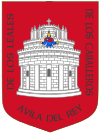Ávila, Spain
| Ávila | |||
|---|---|---|---|
|
Ávila with its famous town walls
|
|||
|
|||
| Nickname(s): Ávila de los Caballeros, Ávila del Rey, Ávila de los Leales | |||
| Motto: Una ciudad para todos... (A town for everyone...) | |||
| Coordinates: 40°39′N 4°41′W / 40.650°N 4.683°WCoordinates: 40°39′N 4°41′W / 40.650°N 4.683°W | |||
| Country |
|
||
| Autonomous Community |
|
||
| Province | Ávila | ||
| Government | |||
| • Mayor | Miguel Ángel García Nieto (PP) | ||
| Area | |||
| • Land | 231.9 km2 (89.5 sq mi) | ||
| Elevation | 1,132 m (3,714 ft) | ||
| Population (2013) | |||
| • Total | 59,258 | ||
| Time zone | CET (UTC+1) | ||
| • Summer (DST) | CEST (UTC+2) | ||
| Postal code | 05001 - 05006 | ||
| Area code(s) | 34 (Spain) + 920 (Ávila) | ||
| Website | http://www.avila.es (Spanish) | ||
| Old Town of Ávila with its Extra-Muros Churches | |
|---|---|
| Name as inscribed on the World Heritage List | |
 |
|
| Location | Spain |
| Type | Cultural |
| Criteria | iii, iv |
| Reference | 348 |
| UNESCO region | Europe and North America |
| Inscription history | |
| Inscription | 1985 (9th Session) |
Ávila (Spanish pronunciation: [ˈaβila]; Latin: Abila and Obila) is a Spanish town located in the autonomous community of Castile and León, and is the capital of the Province of Ávila.
It is sometimes called the Town of Stones and Saints, and it claims that it is one of the towns with the highest number of Romanesque and Gothic churches per capita in Spain. It has complete and prominent medieval town walls, built in the Romanesque style. The town is also known as Ávila de los Caballeros, Ávila del Rey and Ávila de los Leales (Ávila of the Knights, the King and the Loyalists), each of these epithets being present in the town standard.
The writer José Martínez Ruiz, in his book El alma castellana (The Castilian Soul), described it as "perhaps the most 16th-century town in Spain", and it was declared a UNESCO World Heritage Site in 1985.
Situated 1132 metres (3714 feet) above sea level on a rocky outcrop on the right bank of the Adaja river, a tributary of the Duero, Ávila is the highest provincial capital in Spain. It is built on the flat summit of a rocky hill, which rises abruptly in the midst of a veritable wilderness; a brown, arid, treeless table-land, strewn with immense grey boulders, and shut in by lofty mountains.
Ávila's position results in a temperate Mediterranean climate (Csb, according to the Köppen climate classification), with warm summers and chilly winters with snowfalls, bordering on a cold semi-arid climate (BSk). The hottest month, July, has an average temperature of 20.6 °C (69 °F), and the coldest month, January, has an average of 3.0 °C (37 °F). The average annual precipitation is 416 mm (16.38 in). Annual rainfall is low compared to surrounding areas, implying that it lies in a rain shadow. The Adaja is dry for several months of the year and the town has historically had water supply problems.
...
Wikipedia



